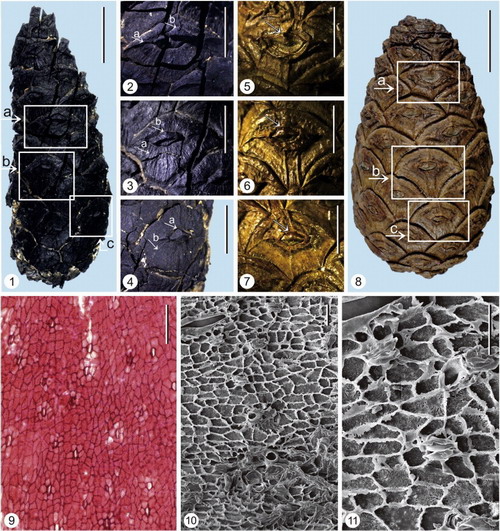Pinus massoniana Lambert, a species with long slender needles of about 12–20 cm, is an endemic conifer distributed mostly in southern, central and eastern parts of China. Some populations of P. massoniana are also found on Taiwan (eastern China) and Hainan Island (southern China), but the paleogeographical evidence for this distribution pattern is lacking.
Prof. ZHOU Zhekun and his team of Xishuangbanna Tropical Botanical Garden (XTBG) collected some well-established cone fossils from outcrops located in Dashidong Village (23°15′N, 104°15′E, 1482 m a.s.l.), Wenshan prefecture, SE Yunnan, China. The fossil remains include a three-imensional seed cone and associated needles which have well preserved cuticles. The fossil seed cone and associated needles from the upper Miocene Wenshan Flora show identical morphological characters to P. massoniana.
The researchers compared the fossils with the extant variants in the genus Pinus (P. massoniana var. shaxianensis Zhou, P. massoniana var. massoniana Lambert and P. massoniana var. hainanensis Cheng et Fu). The comparison results showed that the fossils closes resemble P. massoniana var. hainanensis, a tropical montane thermophilic and hygrophilous plant restricted to Hainan Island in southern China.
Based on the differences in morphological features of seed cones, tree variations among extant Pinus massoniana have been recognized. The present discovery of Pinus massoniana var. hainanensis in SW China and P. massoniana var.massoniana from SE mainland China suggests that the differentiation within P. massoniana began in the late Miocene or earlier.
The extant P. massoniana var. hainanensis grows in a humid subtropical to tropical climate. With the global cooling in the Late Neogene, the climate in Hainan has changed accordingly, the cooler climate provided suitable conditions for the southward expansion of Pinus massoniana var. hainanensis. Therefore, these southern populations of P. massoniana var. hainanensis, nevertheless, may have behaved as minor, secondary refugia in the Quaternary Period, and are of comparatively recent origin.
The climatic context of Pinus massoniana from the upper Miocene of Wenshan in SE Yunnan, SW China indicates a warm and humid climate. Lower temperatures would be adverse to the germination of the P. massoniana seeds. The researchers suggested that the disappearance of P. massoniana from southwestern China is likely related to the amplification of monsoon climate after the late Miocene.
The study entitled “The occurrence of Pinus massoniana Lambert (Pinaceae) from the upper Miocene of Yunnan, SW China and its implications for paleogeography and paleoclimate” has been published in Review of Palaeobotany and Palynology

Pinus massoniana-like ovulate cone (Image by ZHANG Jianwei)

Comparisons of fossil with extant species, showing similar morphological features between them
in apophyses, umbos, mucros and epidermal structures. (Image by ZHANG Jianwei)


